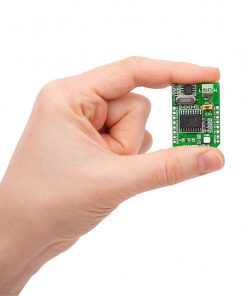CAN SPI Click 3.3V
R450.00 ex. VAT
CAN SPI Click 3.3V is a compact add-on board that provides a complete CAN solution and can be used as a control node in a CAN network. This board features the MCP2515, a stand-alone CAN controller with an SPI interface from Microchip. This Click board™ also uses the SN65HVD230, a CAN Bus transceiver from Texas Instruments, as an interface between an MCP2515 CAN protocol controller and the physical two-wire CAN bus. This Click board™ makes the perfect solution for developing industrial automation, home automation, and the automotive and mobile machine industry.
CAN SPI Click 3.3V Click is supported by a mikroSDK compliant library, which includes functions that simplify software development. This Click board™ comes as a fully tested product, ready to be used on a system equipped with the mikroBUS™ socket.
Stock: Lead-time applicable.
| 5+ | R427.50 |
| 10+ | R405.00 |
| 15+ | R382.50 |
| 20+ | R368.10 |

















